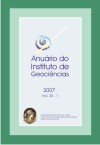Taphonomy of benthic foraminifera from siliciclastic and carbonate sediments
DOI:
https://doi.org/10.11137/2007_1_101-108Abstract
Biological, physical and chemical features work on the bioclasts, which react specifically under diverse environmental conditions. As consequence of the environment stress, the taphonomic signature on foraminiferal tests provides significant paleocological information. This study aims to compare taphonomic properties on foraminiferal tests from carbonate (lagoa Pitanguinha) and siliciclastic (Reserva Tauá) settings. On Reserva Tauá-Pântano da Malhada where identified 10 species and on lagoa Pitanguinha 9, that reveal low diversity. Hyaline and porcelaneous tests occur in carbonate deposits, while in the siliciclastic occurs only the hyaline one. The fragmentation was significant to both depositional environments, the dissolution was faintly higher on the siliciclastic and cyanobacterial microbioerosion was found exclusively on the carbonate. Ammonia tepida shows a high frequency, possessing great rates of bioerosion, fragmentation and dissolution.Downloads
Download data is not yet available.
Downloads
Published
2007-01-01
How to Cite
Cardoso, M. N. and Senra, M. C. E. (2007) “Taphonomy of benthic foraminifera from siliciclastic and carbonate sediments”, Anuário do Instituto de Geociências. Rio de Janeiro, BR, 30(1), pp. 101–108. doi: 10.11137/2007_1_101-108.
Issue
Section
Article
License
This journal is licensed under a Creative Commons — Attribution 4.0 International — CC BY 4.0, which permits use, distribution and reproduction in any medium, provided the original work is properly cited.















